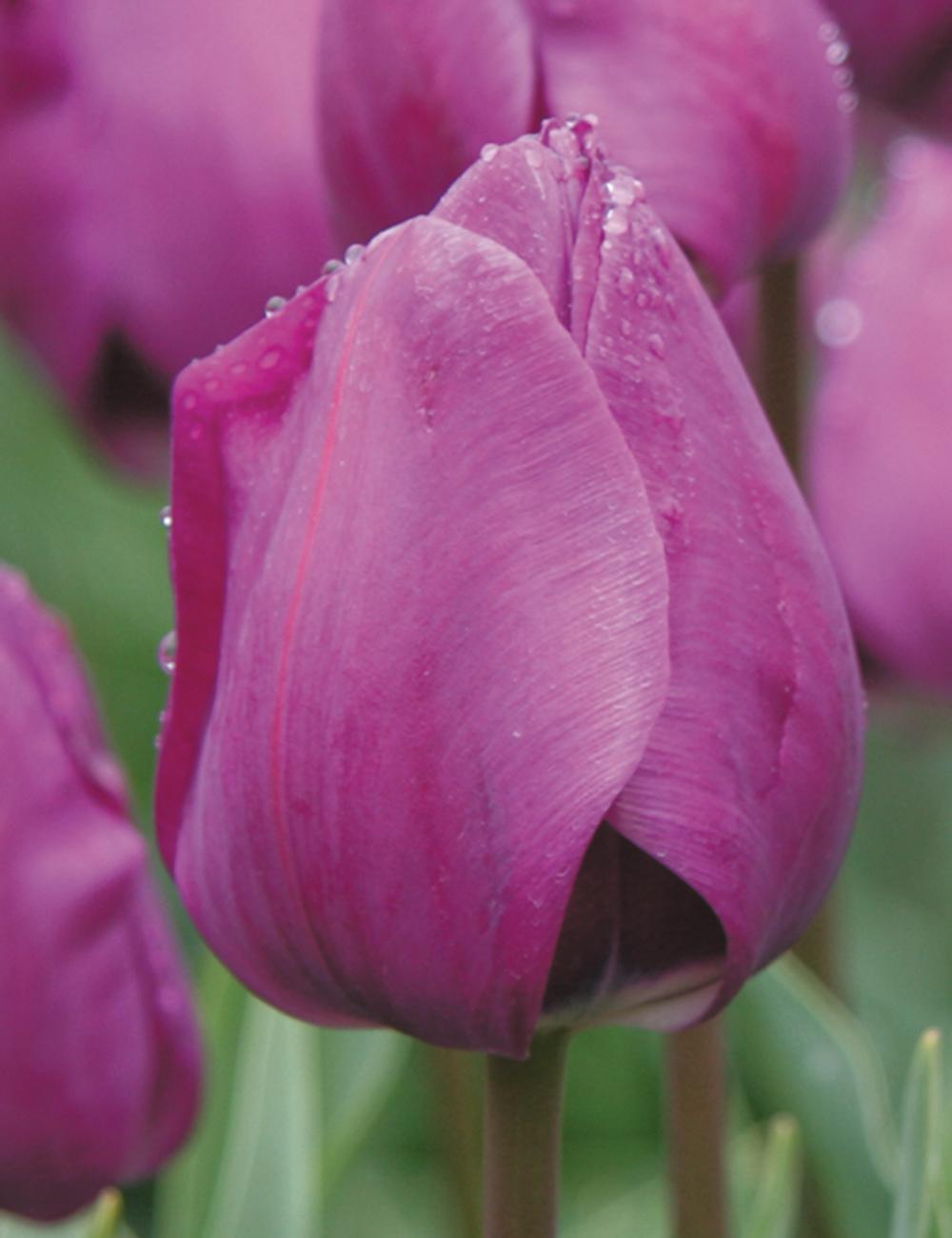
Tulip 'Negrita'
This may look long and complicated so to allay your fears, the simple version is this … Plant your tulips two to three times as deep as they are high in May (around Mother’s Day) into a well drained, fertilised soil. Water in and enjoy! You really can’t go too far wrong; all the extra stuff is the cream on top!
Botanical Name: Tulipa hybrid, T. linifolia, T. linifolia Batalanii Group, T. turkestanica, T. clusiana.
Family: Liliaceae
Plant Type: Bulb
Size (HxW): 30-60cm x 10-15cm ‘Monet’: 40-80cm x 10-20cm. Note: In warmer climates and in dry conditions the height of the tulips will be shorter. Turkestan: 20-30cm x 10cm. Linifolia, ‘Bronze Charm’, ‘Red Hunter’: 10-20cm x 5-10cm. ‘Bright Gem’: 15-25cm x 10-20cm. ‘Cynthia’, ‘Lady Jane’, The Lady, ‘Tinka’: 10-30cm x 10-20cm.
Depth & Spacing: Plant 15-20cm deep and 10-20cm apart - closer for a more impressive effect. Depth is the average of two to three times the height of the bulb. In warmer climates it is more ideal to go the deeper option to protect from heat.
Soil: Well drained, humus rich soils are ideal. Good drainage is the most important element. Species Tulips are more adaptable to poor soils.
Planting Time: Unpack your order on arrival, open the bags and store in a cool position until early May - no need to refrigerate them, they have been cooled naturally in growth. Around Mother’s Day is the perfect timing for tulip planting, as the soil has cooled sufficiently.
Aspect: Full sun in cool climates. Semi shade is better suited in warmer climates.
Climate: Cool to Subtropical. The flowers are pre-formed in the bulb so, in their first year they can grow virtually anywhere, provided you keep them relatively cool. For longevity, cool to Mediterranean climates are ideal.
Frost: Hardy, they actually love it.
Water: Water in to establish, then only if rainfall is low during active growth. If they dry out during their growing time, the stems will not emerge properly and the flowers will shrivel. Lack of water is the cause of most bulb failures, while they are ultimately dry tolerant, it is important to keep them just moist during their initial stages of growth - especially if you are growing them in pots (potting mix is perfectly drained so dries out easily which can compromise their growth). If they get hot and dry in the initial stages, the stems will be short and the flowers only just above the ground. Keep relatively dry during summer dormancy.
Fertiliser: If you are planting into poor soil, it is a good idea to add some organic fertiliser (blood and bone and potash) or a well balanced commercial fertiliser to the soil and dig it though prior to planting. A week or two before is ideal, but if you miss the window, at the time is fine. If you are leaving your tulips in the ground, an annual application of a well balanced fertiliser in spring with the emergence of the foliage and again during/ after flowering is recommended.
In Warm Regions: Ideally plant Monet or Magniflora tulips which are more likely to succeed in your area because they don’t require a long chill time and their stems are naturally long. Planting should be delayed until mid to late May, when the soil has cooled. When you are planting newly purchased tulips from Tesselaar there is no need to refrigerate your bulbs - we have stored them at the correct temperature for them to bloom.
Tulips in the fridge: NB this is not applicable to bulbs you have purchased this year. If you are replanting your own, stored tulip bulbs you will need to refrigerate and here is why; tulips originate mainly from Turkey where there are hot, dry summers and cold winters - as our Australian winters are not cold enough for long enough in many areas, there is a need to refrigerate your bulbs prior to planting. Bulbs store their carbohydrate energy as starch. In order to convert that into the sugars the plant needs to initiate growth, it needs cool temperatures to form the hormones to complete this process. You can start refrigeration from the beginning of April. Place the bulbs in the crisper of the fridge (NOT THE FREEZER) for 6 weeks (4 at a minimum, 8 maximum) in a well-ventilated bag (e.g. open paper bag, egg carton or orange bag). An easy way to remember is to put your tulip bulbs in the fridge around April fool’s day, then plant your bulbs after Mother’s day. Cooling your bulbs will also bring flowering forward, and you are better off having your tulips open early, so they will last better before the heat.
In Cool Regions: There is no need to refrigerate bulbs that you have purchased this season, they can be planted straight into the ground. If you live in an area that receives frosts in winter there is no need to refrigerate your bulbs ever - and they can remain in the ground if they are shaded over summer and have soil with good drainage. In cool to temperate regions we recommend planting tulip bulbs around Mother’s Day.
Flowering Time: Spring, for specific timing please refer to the catalogue.
After Flower Care: This is an important time as your bulbs are forming for next seasons growth. If you don’t have hundreds, and you have the time it is a good idea to cut off any dead flower stalks, this will stop the bulb concentrating energy on seed production and instead focus it on bulb growth. Keep moist until the foliage has yellowed - this may take up to eight weeks. This time is important for bulb development if you wish to keep your tulips growing for future years. If you are leaving your tulips in the ground to naturalise, fertilise at this time, then you can cut the foliage back to tidy once it has browned. If you are lifting the bulbs, mark their location as the foliage is dying back (try a kebab stick) then carefully lift the bulbs out with a garden fork once the foliage has browned. Allow the bulbs to dry in the shade or in a shed for a few days. Shake off any excess dirt, remove any old flower stalks and store them. It’s best to leave all the smaller bulbs attached to the larger bulb, if cared for each year, they will soon grow into flowering size, then see ‘Storage’ below. In temperate and cool zones as well as some Mediterranean areas, you don’t need to lift your bulbs if;
• You live in a climate that receives frost.
• Your tulip bulbs are sheltered from the hot summer sun - through shade from trees/perennials or a thick layer of mulch.
• The bulbs are in well drained soil so won’t sit in water.
Storage: Store bulbs in a cool, airy and dry position ideally with temperatures between 15-23C. If temperatures regularly exceed 30C it will adversely affect the flower inside the bulb. You could use old stockings, the net bags they come in or egg cartons to store your bulbs. They allow the air to flow around the bulbs. If tulips get too hot they respire which wastes their energy, so they won’t flower as well. Keep the stored bulbs out of reach of rodents.
Notes: Don’t forget the critical time if you want to regrow your bulbs for future seasons is after flowering as the foliage is dying back - this is when they need to be cool, moist and fertilised. Species tulips can be left in the ground to naturalise.

